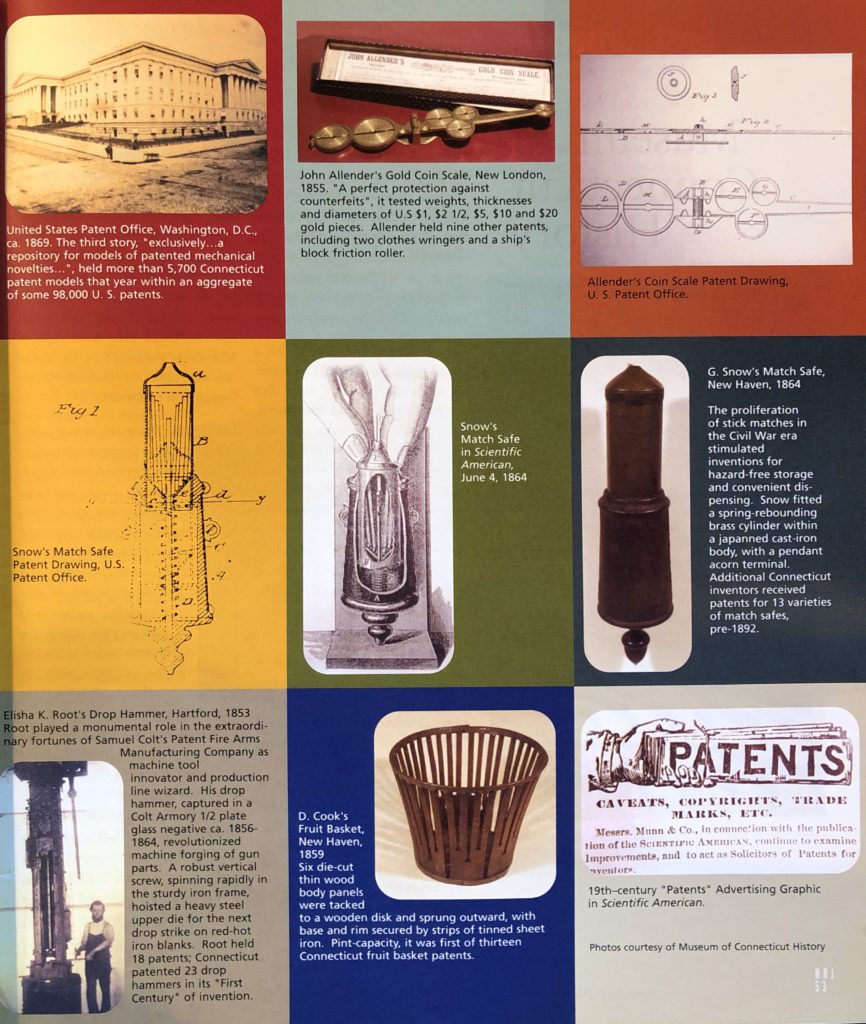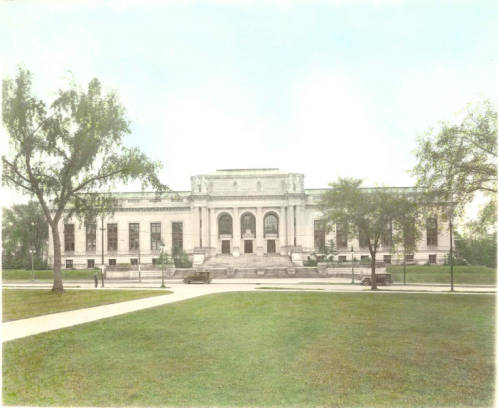By Cynthia Cormier
(c) Connecticut Explored Inc. Spring 2005
Subscribe/Buy the Issue!
The 1910 white marble building on Capitol Avenue in Hartford that houses the State Library and the Connecticut Supreme Court is also home to the Museum of Connecticut History. Here, through the museum’s artifacts, some of which date back to the 17th century, visitors can see the often intertwined stories of the state’s industrial, governmental, political, and military histories.
The grand gallery of Memorial Hall, a magnificently restored and awe-inspiring formal parlor in the Beaux-Arts style which visitors enter upon arrival, features eight large murals representing 350 years of Connecticut’s industry by county. They provide a rich, visual picture of the impressive history of manufacturing in this state and are a fine introduction to the Connecticut Collections. The murals were painted by Connecticut artist and teacher Michael Borders. Also lining the walls are seventy-one portraits of the governors of Connecticut.
 The Connecticut Collections galleries, on the east side of Memorial Hall, are dedicated to the state’s important role in American industry and manufacturing. Connecticut was known for the precision manufacture of firearms, clocks, hardware, and tools. Examples of products of Connecticut inventors and manufacturers such as Colt, Whitney, Terry, Winchester, Stanley, and others are highlighted. Such varied products as forks, knives, vacuum cleaners, toasters, typewriters, and hair dryers are some of the Connecticut-made products that many museum visitors may recognize from their youth. Especially attractive is the display of Connecticut art deco, including toasters, clocks, blenders, flashlights, barware, and other utilitarian objects made by Chase Brass and Copper of Waterbury, Manning-Bowman Co. of Meriden, and the General Electric Company of Bridgeport.
The Connecticut Collections galleries, on the east side of Memorial Hall, are dedicated to the state’s important role in American industry and manufacturing. Connecticut was known for the precision manufacture of firearms, clocks, hardware, and tools. Examples of products of Connecticut inventors and manufacturers such as Colt, Whitney, Terry, Winchester, Stanley, and others are highlighted. Such varied products as forks, knives, vacuum cleaners, toasters, typewriters, and hair dryers are some of the Connecticut-made products that many museum visitors may recognize from their youth. Especially attractive is the display of Connecticut art deco, including toasters, clocks, blenders, flashlights, barware, and other utilitarian objects made by Chase Brass and Copper of Waterbury, Manning-Bowman Co. of Meriden, and the General Electric Company of Bridgeport.
Connecticut Collections also includes a section dedicated to Connecticut’s military contributions, from the colonial wars to Desert Storm. Flags, portraits, weapons, uniforms, and memorabilia are on display. Of particular interest are the diary of Private Henry E. Savage of Company G, 16th Connecticut volunteers, and other mementos preserved by Connecticut soldiers held captive in Andersonville during the Civil War. Recently added to the collection is the uniform worn by Sergeant Jennifer A. Smith of the Connecticut National Guard while serving in Desert Storm. Additional artifacts, relating to Connecticut’s political history, include a display of campaign signs and buttons, women’s suffrage banners, and a voting booth from the early 20th century.
Next is the Colt Firearms gallery. Throughout the history of American firearms no name is more recognizable than that of Hartford’s Samuel Colt (1814-1862). Colt’s genius in both inventing and marketing helped make Connecticut a major center for firearms manufacturing throughout the 19th and 20th centuries. Firearms collectors from around the globe trek to the museum to see one of the finest assemblages of early Colt prototypes, factory models, and experimental firearms in the world. Colt-made Gatling guns, shotguns, and automatic weapons are featured as is the original gilded Rampant Colt statue that had adorned the Hartford Colt factory and was acquired by the museum in 1995. The display is enriched by historic photographs of the Colt factory and its workers.
Finally, the most prominent piece in the museum’s collection is the Royal Charter of 1662, which has long been Connecticut’s symbol of its liberties. Displayed behind glass at the far end of Memorial Hall, the Royal Charter is massive. The impressive white oak frame, including the crest made from Hartford’s famed Charter Oak tree, was added in 1878 and is densely carved with oak leaves and acorns. Charles De Wolf Brownell’s painting of the Charter Oak (painted in 1857, the year the enormous tree fell) hangs above the Royal Charter. Also on display are the 1639 Fundamental Orders, which bound the three original towns of Windsor, Wethersfield, and Hartford into a colonial entity, the state constitutions of 1818 and 1964, and Connecticut’s copy of the United States Bill of Rights.
Cynthia Cormier is director of education and curatorial services at Hill-Stead Museum and chairs HRJ’s editorial board.
Explore!
Museum of Connecticut History
Connecticut State Library
231 Capitol Avenue, Hartford, CT 06106.
It is open Monday to Friday, 9 A.M. to 4 P.M. and Saturday, 9 A.M. to 3 P.M. Admission is free. For more information visit www.cslib.org.
Read more stories from the Museum of Connecticut history by searching for David Corrigan and Dean Nelson in the box at the top right of the page, and read stories about products made and invented in Connecticut on our TOPICS page.

